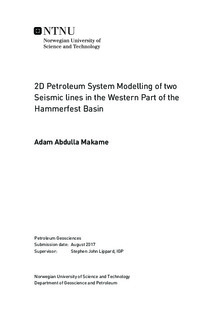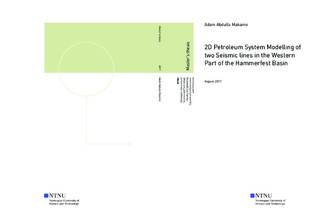| dc.description.abstract | The study focuses on 2D basin modelling of the Hammerfest Basin to understand the petroleum system of the western part of the Hammerfest Basin and how it was affected by uplift and erosion that occurred during Cenozoic time. Two interpreted seismic sections BSS01-104 and BSS01-106 were loaded in PetroMod software for modelling the petroleum system of the area.
The petroleum system of the Hammerfest Basin consists of source rocks of Middle to Late Triassic (Snadd and Kobbe Formations) and Late Jurassic to Early Cretaceous ages (Hekkingen Formation). Reservoir rocks are of Early to Middle Jurassic age (Sto and Tubaen Formations) and the seal rocks are of Middle to Late Jurassic age (Fuglen Formation), Late Jurassic to Early Cretaceous (Hekkingen Formation) and Lower Cretaceous shales. The maturity indicators, such as temperature, vitrinite reflectance and transformation ratio, were used to determine the maturity of the source rocks.
The Triassic potential source rocks (Snadd and Kobbe Formations) of the area are highly matured and have generated large quantities of hydrocarbons. The Hekkingen Formation of Late Jurassic to Early Cretaceous age is also considered as a potential source rock but it is not matured enough. The modelling shows that the deeper source rocks of Triassic age have generate significant amounts of hydrocarbons, but the upper source rocks of Late Jurassic to Early Cretaceous continue to generate hydrocarbons (both oil and gas) to the present day.
The model has incorporated three phases of erosion. The first phase of erosion took place during 75 to 60 Ma in the Late Cretaceous which eroded 200 m of the Kveite Formation and the second phase took place during 40 to 35 Ma in the Paleogene which eroded 300 m of Torsk Formation and the third phase was between 3.5 to 0.01 Ma in the Neogene which was eroded a further 500 m of Torsk Formation. Therefore, a total of 1000 m thickness of erosion has been modelled. | |

